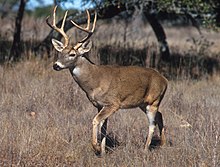Ruminantia
| Ruminantia | |
|---|---|

| |
| White-tailed deer | |
| Scientific classification | |
| Domain: | Eukaryota |
| Kingdom: | Animalia |
| Phylum: | Chordata |
| Class: | Mammalia |
| Order: | Artiodactyla |
| Clade: | Ruminantiamorpha Spaulding et al., 2009 |
| Suborder: | Ruminantia Scopoli, 1777 |
| Families | |
Ruminantia is a taxon within the order Artiodactyla that includes many of the well-known large grazing or browsing mammals: among them cattle, goats, sheep, deer, and antelope. All members of the Ruminantia employ foregut fermentation and are ruminants: they digest food in two steps, chewing and swallowing in the normal way to begin with, and then regurgitating the semidigested cud to rechew it and thus extract the maximum possible food value.
Evolution
Ruminantiamorpha is a total clade of artiodactyls defined, according to Spaulding et al., as "Ruminantia plus all extinct taxa more closely related to extant members of Ruminantia than to any other living species."[1] Spaulding grouped some genera of the family Anthracotheriidae as within Ruminantiamorpha but not Ruminantia, but placed other anthracotheres within Ruminantiamorpha's sister clade, Cetancodontamorpha.
The Tragulidae are the basal family in the Ruminantia.[2]
The ancestral Ruminantia karyotype is 2n = 48 similar to that of cetartiodactyls.[2]
- ORDER ARTIODACTYLA
- Suborder Suina: pigs and peccaries
- Suborder Tylopoda: camels and llamas
- Suborder Cetruminantia: ruminants, whales and hippos
- unranked Ruminantia
- Infraorder Tragulina (paraphyletic)
- Family †Prodremotheriidae
- Family †Hypertragulidae
- Family †Praetragulidae
- Family †Protoceratidae[1]
- Family Tragulidae: chevrotains, 6 living species in 4 genera
- Family †Archaeomerycidae
- Family †Lophiomerycidae
- Infraorder Pecora
- Family Cervidae: deer and moose, 49 living species in 16 genera
- Family †Gelocidae
- Family †Palaeomerycidae
- Family †Hoplitomerycidae
- Family †Climacoceratidae
- Family Giraffidae: giraffe and okapi, 2 living species in 2 genera
- Family Antilocapridae: pronghorn, one living species in one genus
- Family †Leptomerycidae[1]
- Family Moschidae: musk deer, 4 living species in one genus
- Family Bovidae: cattle, goats, sheep, and antelope, 135 living species in 48 genera
Not all ruminants belong to the Ruminantia.[3] Tylopoda and Hippopotamidae are classified as pseudoruminants.[3] A number of other large grazing mammals, e.g. horses and Kangaroos, employ hindgut fermentation as an adaptation for surviving on large quantities of low-grade food.
References
- ^ a b c "Relationships of Cetacea (Artiodactyla) among mammals: increased taxon sampling alters interpretations of key fossils and character evolution". PLoS ONE. 4 (9): e7062. 2009. doi:10.1371/journal.pone.0007062. PMC 2740860. PMID 19774069.
{{cite journal}}: CS1 maint: unflagged free DOI (link) - ^ a b Kulemzina AI, Yang F, Trifonov VA, Ryder OA, Ferguson-Smith MA, Graphodatsky AS (2011) Chromosome painting in Tragulidae facilitates the reconstruction of Ruminantia ancestral karyotype. Chromosome Res.
- ^ a b Whistler, D. P. and S. D. Webb. 2005. New goatlike camelid from the late Pliocene of Tecopa Lake Basin, California. Natural History Museum of Los Angeles County Contributions in Science 503:1-40.
External links
- . Encyclopædia Britannica (11th ed.). 1911.
